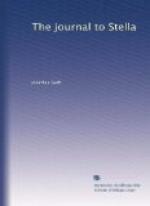20 This sentence is almost obliterated.
Letter 54.
1 The Ms. of this letter has not been preserved.
2 See Letter 26, note 2.
3 Swift’s friend, Dr. Pratt (see Letter 2, note 14), was then Provost of Trinity College, Dublin.
4 Samuel Molyneux, then aged twenty-three, was the son of William Molyneux (1656-1698), M.P. for Dublin University, a writer on philosophical and scientific subjects, and the friend of Locke. Samuel Molyneux took his M.A. degree in Dublin in 1710, and in 1712 visited England. He was befriended by the Duke of Marlborough at Antwerp, and in 1714 was sent by the Duke on a mission to the Court of Hanover. He held office under George I., but devoted most of his attention to astronomical research, until his death in 1728.
5 Probably “The Case of Ireland’s being bound by Acts of Parliament in England stated” (1698).
6 Oxford and Bolingbroke.
7 See Letter 36, note 18.
8 See Letter 51, Aug. 7, 1712.
9 George Ridpath (died 1726), a Whig journalist, of
whom Pope (Dunciad, i. 208) wrote—
“To Dulness Ridpath
is as dear as Mist.”
He edited the Flying Post for some years, and also
wrote for the Medley in 1712. In September William
Hurt and Ridpath were arrested for libellous and seditious
articles, but were released on bail. On October
23 they appeared before the Court of Queen’s
Bench, and were continued on their recognizances.
In February 1713 Ridpath was tried and, in spite of
an able defence by leading Whig lawyers, was convicted.
Sentence was postponed, and when Ridpath failed to
appear, as ordered, in April, his recognizances were
escheated, and a reward offered for his discovery;
but he had fled to Scotland, and from thence to Holland.
10 See Letter 52, note 5.
11 Lady Orkney’s sister, Barbara Villiers, who married John Berkeley, fourth Viscount Fitz-Hardinge, had been governess to the Duke of Gloucester, Queen Anne’s son. She died in 1708, in her fifty-second year; and on her husband’s death four years later the peerage became extinct.
12 For the street criers, see the Spectator, No. 251.
Letter 55.
1 Addressed to “Mrs. Dingley.” Endorsed “Nov. 26, just come from Portraine”; and “The band-box plot—D: Hamilton’s murther.”
2 Charles Mohun, fifth Baron Mohun, had been twice arraigned of murder, but acquitted; and during his short but turbulent life he had taken part in many duels. Even Burnet could say nothing in his favour.
3 This duel between the Duke of Hamilton (see Letter 27, note 9) and Lord Mohun, who had married nieces of Lord Macclesfield, had its origin in a protracted dispute about some property. The challenge came from Lord Mohun, and the combatants fought like “enraged lions.” Tory writers suggested that the duel was a Whig conspiracy to get rid of the Duke of Hamilton (Examiner, Nov. 20, 1712). The whole subject is discussed from the Whig point of view in Boyer’s Political State for 1712, pp. 297-326.




